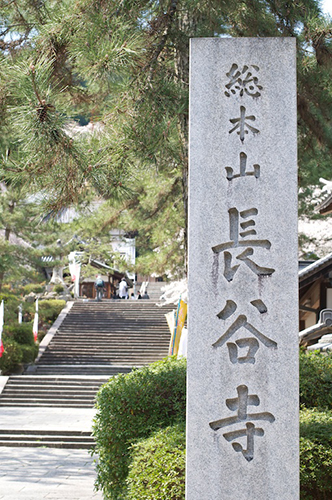150. The "Valley" Radical: 谷
The seven-stroke "valley" radical 谷 is on duty in just one Joyo kanji, the 谷 character itself:
谷 (122: valley)
In this case, the radical name たに works. It corresponds to the Joyo kun-yomi of the 谷 kanji.
If the "valley" radical shifts to the left side of a character, the name たにへん fits. We find 谷 on the left in these kanji:
欲 (987: desire)
谺 (こだま: spirit of a tree), a non-Joyo kanji
Because 谷 is a mere component in 欲, the name たにへん isn't really appropriate, and kanji scholars wouldn't use it, though conceivably laypeople would. That is, radical names are best reserved for the radical that's on duty in a particular kanji.
As for こだま as "spirit of a tree," the Japanese tend to write that as 木霊.

Photo Credit: Christopher Acheson
In Sakurai City, which is in Nara Prefecture on Honshu, this sign marks the location of 長谷寺 (はせでら: Hasedera Temple). It's unclear why 谷 is in this name.
The smaller characters, 総本山 (そうほんざん), do not denote a mountain name, as one might think. Rather, 総本山 can mean "head temple of a sect," as is true here. The Hasedera in Nara is the main temple of the Buzan sect of Shingon Buddhism. There are also temples named Hasedera in Nagano City (Nagano Prefecture) and Kamakura City (Kanagawa Prefecture), but they aren't related to each other.
Etymological Interpretations of 谷
Henshall's newer edition presents various etymologies of the cutely symmetrical 谷:
1. All the diagonal strokes may represent "water flowing," with the 口 symbolizing a "(mountain) spring."
2. The top four strokes might depict "mountain slopes," with the bottom standing for a "valley depression."
3. The top strokes could mean "open up," combining with 口 (mouth, cavity) to yield "wide open mouth" as the overall meaning. If that's true, "mountain valley" appears to be an extended sense, though one researcher posits that "cave from which spring water emerges" is an alternative meaning of 谷.
